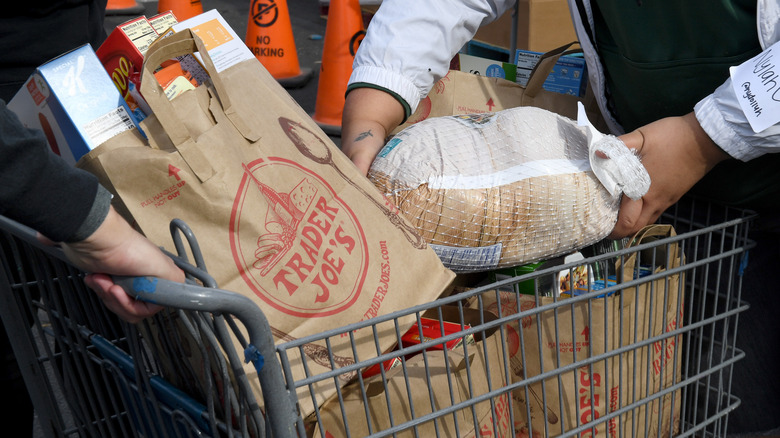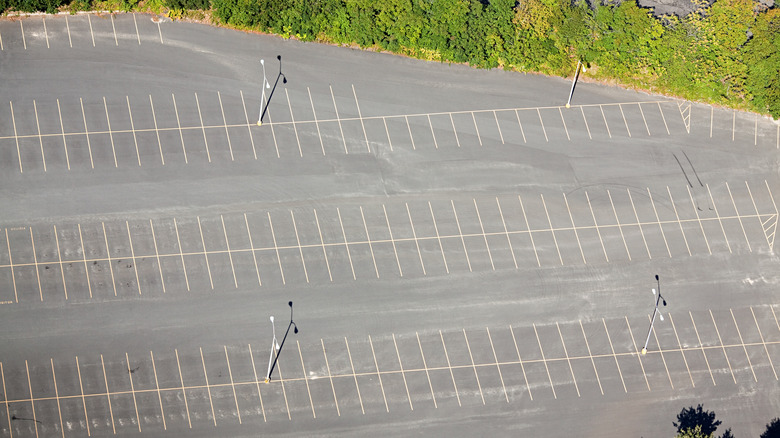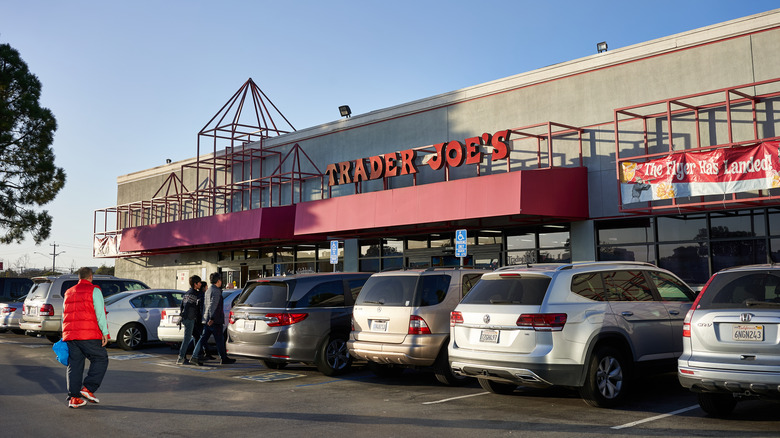Here's Why Trader Joe's Parking Lots Are So Annoyingly Small
Few things in the food world truly unite people. Pizza preferences have strained relationships, and arguments have erupted over who truly invented the Juicy Lucy. You're either a Costco person or a Sam's Club person. But one thing is universally agreed upon: Trader Joe's parking lots are just too small.
Most American grocery stores have sprawling, spacious parking lots. On the other hand, Trader Joe's is infamous for its always-packed, cramped, too-small lots. Finding a parking space on your first loop through the lot is akin to winning the lottery.
Trader Joe's addressed it on the official store podcast (yes, it's true! A TJ's podcast!) during a mini-episode from October 10, 2022, as part of the In Case You Missed It (ICYMI) series. Matt Sloan, the culture and innovation guy at Trader Joe's, says they know parking can be challenging but that isn't the intention, per se. It's comparable to the square footage of the store itself. The lots are smaller than supermarket lots because the store footprints are smaller.
Trader Joe's stores are small for a reason — like its sibling brand, Aldi, smaller stores mean lower prices for the shoppers. That extends to the parking situation. Because a Trader Joe's store is generally 10,000 square feet versus a 50,000 to 70,000 square foot supermarket, the parking lots are going to be a lot smaller, too.
It comes down to zoning regulations
"We don't open stores with the world's most ridiculous parking lot on purpose," Matt Sloan said in the podcast. It's not a Trader Joe's conspiracy; it's a byproduct of city regulations.
In the U.S., parking requirements – minimums and maximums — are dictated by each municipality's zoning laws. All building and zoning codes across the country define how much space can be allotted for parking based on the capacity of the building. The city calculates the required parking based on the occupancy a store can handle by its size. This is why larger supermarkets have larger parking lots, and Trader Joe's locations have smaller parking lots: store square footage determines parking lot square footage.
A TikTok creator and city planning educator named Jon Jon Weslowski, known as The Happy Urbanist, explained that parking lots are always a lose-lose; there's never enough parking during peak times and always way too much parking during slow times (if we went by this metric at Trader Joe's, it would seem it's always peak times). Smaller lots reduce this waste of space, resources, and overhead.
Could small parking lots be a good thing?
As developers build storefronts, they must also build parking lots; swaths of empty space that are factored into building costs, and, therefore, into grocery prices. But perhaps there's another silver lining to smaller lots.
Imagine, if you will, a Trader Joe's store on a weekday evening. How long are the checkout lines? How busy are the aisles? How many people are there fighting over the seasonal ube ice cream? Now imagine if all the drivers angling for a parking space were in the store at the same time as you, rather than creeping through the lot and waiting for a space to open. It would be madness.
It's possible the limited parking offerings may act as a way to meter the number of shoppers in the small stores at any given time. In the ICYMI episode, Tara Miller posits that a Trader Joe's can have even more shoppers than a traditional supermarket, but with a seventh of the floor space. And that's with the limited parking everyone knows and hates.
Maybe it encourages carpooling or — where available — public transport, pedestrianism, or bike-riding instead of cars. Maybe small Trader Joe's lots are helping reduce the collective carbon footprint of shoppers. Or, given how much time drivers spend circling for open parking spaces like vultures and idling in various levels of patience, maybe not.


